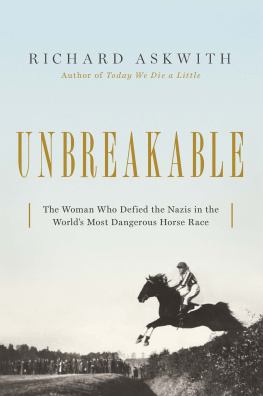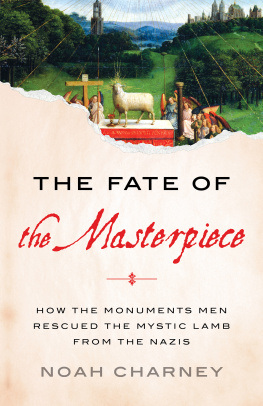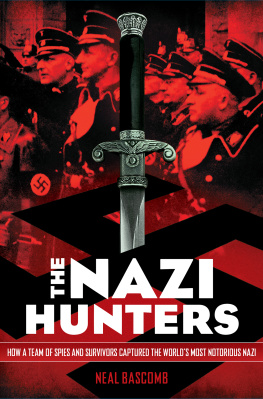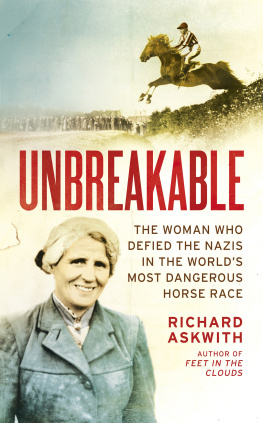Contents

UNBREAKABLE
The Woman Who Defied the Nazis
in the Worlds Most Dangerous Horse Race
RICHARD ASKWITH

PEGASUS BOOKS
NEW YORK LONDON
U NBREAKABLE
Pegasus Books, Ltd.
148 West 37th Street, 13th Floor
New York, NY 10018
Copyright 2019 by Richard Askwith
First Pegasus Books hardcover edition September 2019
All rights reserved. No part of this book may be reproduced in whole
or in part without written permission from the publisher, except by reviewers
who may quote brief excerpts in connection with a review in a newspaper, magazine,
or electronic publication; nor may any part of this book be reproduced, stored in a
retrieval system, or transmitted in any form or by any means electronic, mechanical,
photocopying, recording, or other, without written permission from the publisher.
Library of Congress Cataloging-in-Publication Data is available
ISBN: 978-1-64313-210-5
ISBN: 978-1-64313-271-6 (ebk.)
Contents
T he hill falls down so steeply you can almost touch the flaking bark at the tops of the high conifers, slanting up from below. Patches of undergrowth sprout feebly from the balding earth. The dry soil is rough with trampled scraps of tree; the air, sweet with pine, is still.
We are just below the brow. The gusting April wind has vanished. So has the low moan it carried from the next valley, of traffic on its early evening rush south-west from Prague on highway No. 4.
A rusting chain-link fence, barely kept vertical by cracked concrete pillars, separates us from a tiny pebbledash cottage that clings awkwardly to the slope. The walls are blotched with damp. The black roof tiles are newer. This is what it used to be, says the man with ash-white hair, kicking at some jagged red fragments among the dusty twigs. Asbestos.
Jan Pospil stamps out his Lucky Strike in the debris. Theyll have electricity now, he adds. And running water. They didnt then. His eyes glisten, perhaps from the smoke.
She was my favourite aunt, he explains. Well, greataunt. There were three of them living here, three sisters. I liked Lata best. I was five or six when I first came here. She must have been about seventy. My mother would leave me here to stay for a few days. There wasnt much room: just two bedrooms. You could fit two single beds in each, and the sides touched.
Lata was strict about table manners. But she was kind. She used to send me out to play in the woods. Sometimes shed give me her gun and some ammunition, and tell me to play with that... Later, in his teens, they would sneak away into the woods together and Lata would share secret cigarettes with him.
Behind us, up on the hill, a car can be seen, moving noiselessly on the lane that runs along the ridge. Back then, in the 1970s, it was more likely to be a man on a horse; sometimes more than one. The secret police liked to keep an eye on things round here.
There is no sign of the cottages current occupants, nor of any neighbours. Other dwellings are just visible through the trees, but these are recent additions. You wouldnt expect their occupants to remember Jans greataunts. Yet the elderly sisters must have made an impression on someone. The rocky stream at the bottom of the valley is known as Bab rokle, or Old Womens Gorge. Lata would spend much of each day going up and down the hill to fetch water from a well by the stream, even though she could no longer walk without a stick.
But she never complained, says Jan. None of them did.

For a small nation, the Czechs have an extraordinary gift for producing sporting champions of luminous greatness. Still more remarkable is their rulers gift especially in the twentieth century for disowning them. Emil Ztopek, the runner; Vra slavsk, the gymnast; Olga Fikotov- Connolly, the discus thrower; Martina Navratilov, the tennis player; the near-invincible national mens icehockey team of 19479... All dazzled and conquered their chosen worlds, only to be denounced as traitors or enemies of the people. Some were punished; all were shunned. But none fell so far or for so long as Lata Brandisov, the steeplechase jockey, who displeased not one totalitarian regime but two having already struggled through years of prejudice on account of her gender.
In her prime, between the world wars, Jans greataunt was fted by statesmen and socialites, acclaimed by chanting crowds. Her achievements in the saddle made headlines not just in Czechoslovakia (as it then was) but across Europe: they were astonishing in sporting terms but more astonishing still in the courage and resilience that made them possible. In an age of prejudice she refused to be constrained by convention. At a time of despair she embodied hope and patriotism. Her aristocratic glamour added to her celebrity, but she was also a figure of deep and serious significance for her nation, her sport and her gender.
She faced her ultimate challenge in middle age, confronting the warrior-athletes of the Third Reich in a sporting contest so extreme in its dangers that some would question its right to be called sport. That day alone should have been enough to earn her immortality. Instead, she was stuffed into historys dustbin.
She remained there, in that little cottage in the woods, for thirty years, forgotten and unmentionable. Her sisters would leave at dawn, walking to catch a train, to work all day in a factory on the edge of Prague. Lata, still unsteady on her feet from sporting battles gone by, would stay at home, cleaning, washing, chopping wood, fetching water, with only a dog for company.
Later, as age and hunger gnawed at their bones, the sisters became increasingly reclusive. But once a week they would walk to church, always sitting in the same pews, always returning in single file, always alone with their thoughts like the three kings, says a villager who used to watch. Then, nearly forty years ago, even that procession stopped.
Latas death, in 1981, was barely reported. She is buried abroad. As far as most of her compatriots are concerned, her story might as well have been buried there with her. A few pilgrims say a mass for her each year at the family shrine in the woods above her old home hundreds of miles from her actual resting place. Apart from that, youll struggle to find a Czech or Slovak who has heard of her, outside the hardcore racing community. In the West, she is almost entirely forgotten. Yet the life of Lata Brandisov was too remarkable to deserve such oblivion. Her character, courage and achievements made a mark that mattered in European history, and made a permanent difference to the opportunities available to the women who came after her. If ever an athlete deserved to have a permanent record set down of who she was and what she did, she does.
Some would say it is too late. There are too few witnesses, too many missing documents. In a cheerful bar among the bleak high-rises of the Prague suburb of Chodov, the respected journalist and racing historian Martin Cp spends several hours kindly explaining the difficulties to me. He himself has spent twenty years researching a still-unfinished book about the Czech Derby; his knowledge of his nations incomplete racing archives is unrivalled, and he is painfully aware of every gap. Its a fascinating story, he tells me, but it will be terribly hard. So many records have been lost.
Martin abata, a television pundit famous among Czechs for his encyclopaedic knowledge of the bloodcurdling horse race that made Lata a sporting legend, tells me much the same a few days later, in a caf in the eastern Bohemian town of Pardubice. The story of Lata Brandisov is an extremely interesting one. I would love to be able to share all the details with you. But I cant. They are lost.













